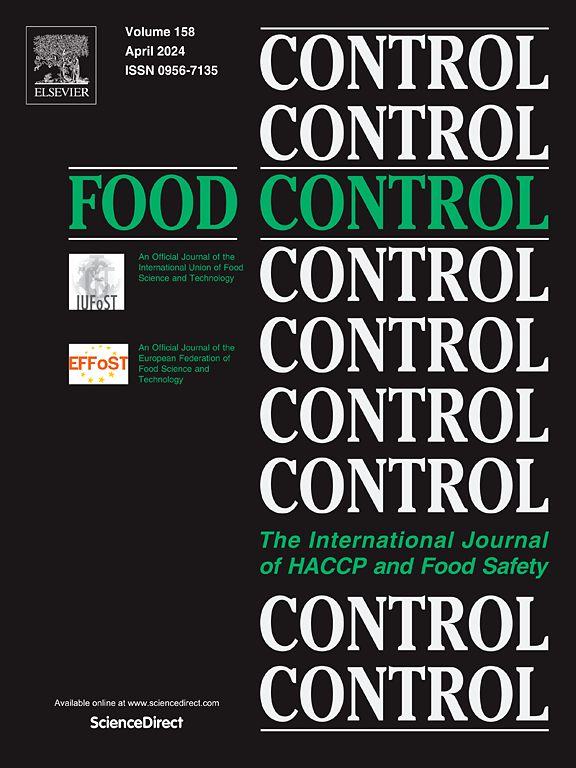Synergistic activity of sodium benzoate and oregano essential oil combinations at pH 5.0 in tryptic soy broth and washing solution for cherry tomatoes
IF 5.6
1区 农林科学
Q1 FOOD SCIENCE & TECHNOLOGY
引用次数: 0
Abstract
Combinations of antimicrobials with synergistic activities can reduce the concentration of antimicrobials for the safety and preservation of fresh produce. The objective of this study was to assess the interaction between sodium benzoate (NaB) and oregano essential oil (OEO) on Salmonella Enteritidis ATCC H4267 and Listeria monocytogenes Scott A and their application as alternative wash solutions to enhance microbial safety of cherry tomatoes. The results showed that combinations of 500 ppm NaB and 200–400 ppm OEO at pH 5.0 had a synergistic effect (fractional inhibition concentration index of 0.75) on S. Enteritidis and L. monocytogenes. The minimum inhibitory concentrations (MICs) of NaB and OEO in combinations were at least two-folds lower than the MICs of individual compounds, and inhibition by antimicrobial combinations in time-kill assays was more significant than NaB but was similar to OEO when assessed at one-half or one-quarter of the MICs. For washing cherry tomatoes inoculated with S. Enteritidis and L. monocytogenes at antimicrobial concentrations being 3 times of the MICs, the OEO treatment was the most efficacious, showing absence of the cross-contamination and no interference by 1 % organic load. The NaB wash was less efficacious than the OEO treatment, and the cross-contamination was evident. The combination of NaB and OEO achieved similar outcomes as the OEO solution, but at 50 % of the OEO concentration, which may be significant to reduce the potential negative sensory effect of OEO. Therefore, NaB and OEO combinations are potential alternative solutions for washing fresh produce.
苯甲酸钠和牛至精油组合在pH为5.0的胰蛋白酶肉汤和圣女果洗涤液中的增效作用
具有协同作用的抗菌剂组合可以降低抗菌剂的浓度,以保证新鲜农产品的安全和保存。本研究旨在探讨苯甲酸钠(NaB)和牛至精油(OEO)对大肠沙门氏菌ATCC H4267和单核细胞增多李斯特菌Scott A的相互作用及其作为替代洗涤液对圣女果微生物安全性的影响。结果表明,500 ppm NaB和200-400 ppm OEO在pH 5.0条件下对肠炎沙门氏菌和单核增生乳杆菌具有协同抑制作用(分数抑制浓度指数为0.75)。NaB和OEO联合使用的最低抑制浓度(mic)比单个化合物的最低抑制浓度(mic)至少低两倍,抗菌药物组合在时间杀伤试验中的抑制作用比NaB更显著,但在mic的一半或四分之一评估时与OEO相似。对接种了肠炎沙门氏菌和单核增生乳杆菌的圣女果,在抗菌浓度为mic的3倍时,OEO处理效果最好,没有交叉污染,也没有1%有机负荷的干扰。NaB洗涤效果不如OEO处理,交叉污染明显。NaB和OEO的组合取得了与OEO溶液相似的结果,但在50%的OEO浓度下,这可能显著降低了OEO潜在的负面感觉效应。因此,NaB和OEO组合是清洗新鲜农产品的潜在替代解决方案。
本文章由计算机程序翻译,如有差异,请以英文原文为准。
求助全文
约1分钟内获得全文
求助全文
来源期刊

Food Control
工程技术-食品科技
CiteScore
12.20
自引率
6.70%
发文量
758
审稿时长
33 days
期刊介绍:
Food Control is an international journal that provides essential information for those involved in food safety and process control.
Food Control covers the below areas that relate to food process control or to food safety of human foods:
• Microbial food safety and antimicrobial systems
• Mycotoxins
• Hazard analysis, HACCP and food safety objectives
• Risk assessment, including microbial and chemical hazards
• Quality assurance
• Good manufacturing practices
• Food process systems design and control
• Food Packaging technology and materials in contact with foods
• Rapid methods of analysis and detection, including sensor technology
• Codes of practice, legislation and international harmonization
• Consumer issues
• Education, training and research needs.
The scope of Food Control is comprehensive and includes original research papers, authoritative reviews, short communications, comment articles that report on new developments in food control, and position papers.
 求助内容:
求助内容: 应助结果提醒方式:
应助结果提醒方式:


